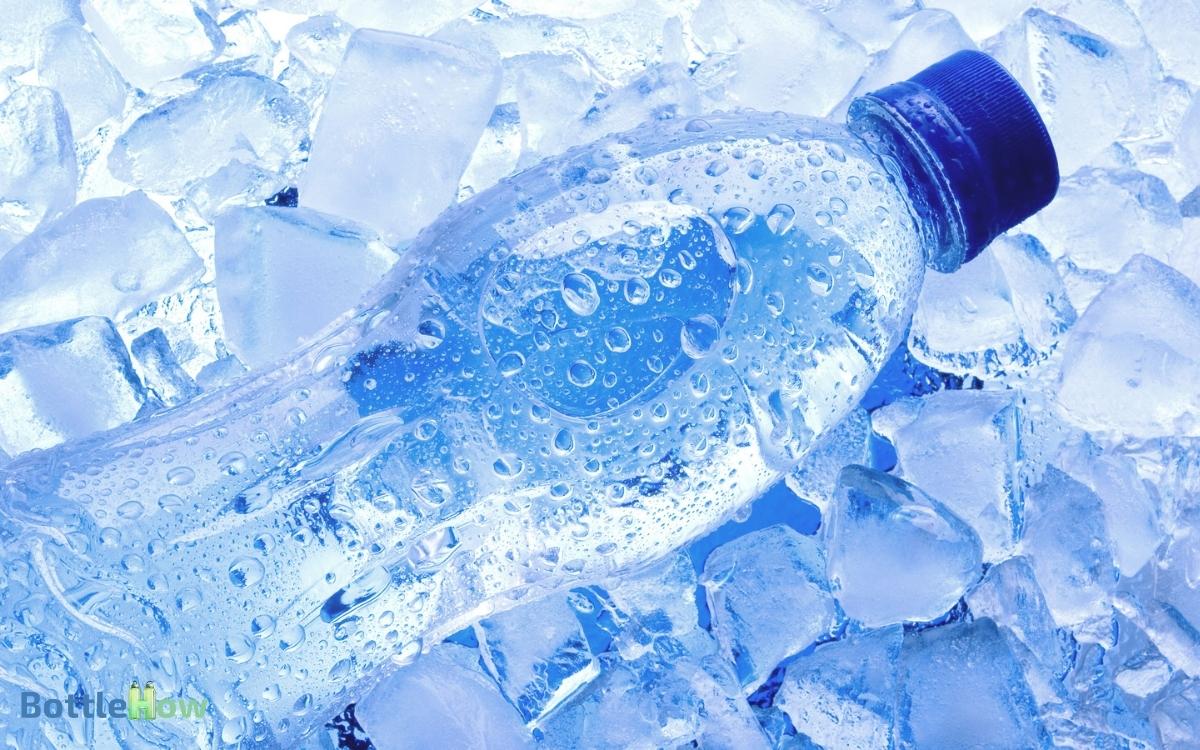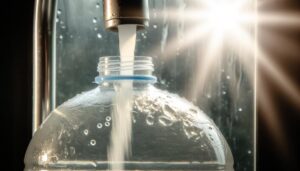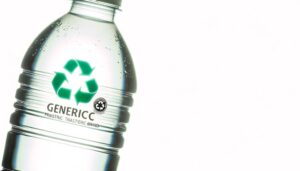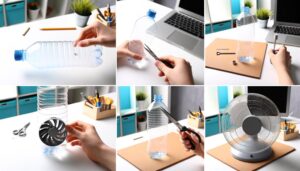Can You Freeze a Water Bottle? Yes!
You can freeze a water bottle, but choose a suitable material like high-density polyethylene (HDPE) or stainless steel.
Fill the bottle to 90% capacity to allow for expansion, as water forms a crystalline structure and stabilizes hydrogen bonds at 0°C (32°F). Avoid glass bottles due to shattering risks.
Leave space to prevent rupture and use BPA-free plastic to minimize contamination. Freeze time varies with temperature and bottle size, typically taking 4-6 hours at -18°C (0°F).
Understanding these guidelines guarantees safe and effective freezing—you might want to know the best practices for top-notch results.

Key Takeaways
The Science of Freezing Water
When you freeze water, its molecules slow down and arrange into a crystalline structure, forming solid ice. This process occurs at 0°C (32°F), the freezing point of water.
As the temperature drops, kinetic energy decreases, causing hydrogen bonds to stabilize in a hexagonal pattern. This structure makes ice less dense than liquid water, which is why ice floats.
You should note that the rate at which water freezes depends on factors like volume, initial temperature, and freezer efficiency.
Additionally, supercooling can occur, where water remains liquid below its freezing point until a nucleation site triggers crystallization.
Understanding these principles helps you predict and control the freezing process, ensuring the best possible results when freezing a water bottle.
Types of Water Bottles
When considering freezing a water bottle, you’ll need to evaluate the material and durability, as well as insulation and performance.
Stainless steel bottles offer excellent durability but limited flexibility in freezing due to potential structural stress.
Conversely, high-density polyethylene (HDPE) bottles exhibit better performance in low temperatures, providing ideal insulation and resilience.
Material and Durability
Different types of water bottles, such as stainless steel, plastic, and glass, offer varying levels of durability and suitability for freezing.
Stainless steel bottles provide excellent durability but can be affected by thermal expansion, potentially causing deformation.
Plastic bottles, particularly those made from high-density polyethylene (HDPE), generally withstand freezing well, given their flexibility and resistance to cracking. However, some plastics may release chemicals when exposed to extreme temperatures.
Glass bottles, while offering excellent taste preservation and hygiene, are prone to shattering when frozen due to the expansion of water as it turns to ice.
Data indicates that HDPE plastic bottles are most suitable for freezing, balancing durability, and safety. Always check manufacturer guidelines to make sure your bottle is freezer-safe.
Insulation and Performance
Understanding the insulation properties and performance of various types of water bottles is essential to selecting the right one for freezing.
Stainless steel bottles, with their vacuum insulation, maintain temperature effectively but may not be ideal for freezing due to expansion risks.
Plastic bottles, particularly those made from high-density polyethylene (HDPE), offer flexibility and can withstand freezing temperatures without cracking.
Glass bottles, though effective insulators, are prone to shattering when frozen. Data indicates that HDPE bottles can endure temperatures as low as –40°F, making them suitable for freezing.
Remember, when freezing any bottle, don’t fill it completely to allow for water expansion, preventing damage.
Select a water bottle based on material compatibility with freezing to ensure top performance.
Preparing Your Water Bottle
You need to select a bottle made of durable, freezer-safe material to prevent cracking.
Fill the bottle to about 90% capacity to allow for water’s expansion upon freezing. Guarantee the cap is tightly sealed to avoid contamination and leakage.
Choosing Right Bottle
Selecting an appropriate water bottle involves considering material composition, thermal properties, and structural integrity to guarantee the best freezing results.
- Material Composition: Opt for BPA-free plastic or stainless steel. BPA-free plastics resist cracking, while stainless steel offers durability.
- Thermal Properties: Avoid glass bottles as they can shatter under freezing conditions. Plastic and stainless steel can withstand temperature changes better.
- Structural Integrity: Choose bottles with flexible walls to accommodate water expansion when it freezes.
- Size and Shape: Select a bottle that’s not completely rigid and has a wide mouth for easy filling and ice expansion.
Filling and Sealing
After choosing the right bottle, fill it to about three-quarters full with water to allow space for ice expansion.
Water expands approximately 9% when it freezes, so leaving this space is essential to prevent the bottle from bursting.
Make sure the water is clean to avoid contamination. Seal the bottle tightly to prevent any external particles from entering.
Use a screw cap for a secure, airtight seal. If your bottle has a sports cap, double-check for any potential leaks.
Once sealed, place the bottle upright in the freezer. This position helps maintain structural integrity and ensures even freezing.
By following these steps, you effectively minimize the risk of damage and guarantee safe consumption post-freezing.
Can You Put a Plastic Water Bottle in the Freezer?
Yes, you can put a plastic water bottle in the freezer, but there are some precautions to consider. Firstly, ensure that the bottle is designed to be frozen, as not all plastic bottles can withstand the expansion of water when it freezes. Additionally, avoid overfilling the bottle, as water expands when it freezes and may cause the bottle to crack or burst. It’s also important to check that the plastic is BPA-free to prevent potential chemical leaching. However, be cautious when reading about unrelated topics like a silencer using a water bottle, as modifying objects for unintended purposes can be unsafe and illegal.
Look for bottles labeled as freezer-safe or those made from materials like high-density polyethylene (HDPE) or polyethylene terephthalate (PET), which are more resistant to cracking when frozen.
Additionally, leave some space at the top of the bottle for the water to expand as it freezes. If the bottle is filled to the brim, the expanding ice could cause the bottle to burst.
Lastly, keep in mind that freezing water can affect the taste and texture of the water when it thaws. Some people may notice a difference in taste or texture after freezing and thawing water.
Dos and Don’ts
When freezing a water bottle, make sure it’s not filled to the brim to prevent it from bursting due to the expansion of ice.
Follow these dos and don’ts for best results:
- Do leave about 10% of the bottle empty. Water expands by approximately 9% when it freezes.
- Don’t use glass bottles; they’re more likely to shatter under pressure from the expanding ice.
- Do use BPA-free plastic bottles, which are designed to withstand freezing temperatures.
- Don’t freeze carbonated water; the pressure from both the carbonation and the expanding ice can cause the bottle to rupture.
Potential Risks
Ignoring the guidelines for freezing water bottles can lead to various potential risks, including bottle rupture and contamination.
As water freezes, it expands by approximately 9%, exerting pressure on the bottle. This expansion can cause the bottle to crack or burst, leading to leakage.
Additionally, if the bottle isn’t made from food-grade materials, microplastics and harmful chemicals could leach into the water upon freezing.
Contamination risks also arise from improper sealing, which can allow bacteria to enter. Freezing temperature fluctuations can further degrade the plastic, releasing toxins like BPA.
Understanding these risks is vital to ensuring the safety and integrity of your frozen water. Always consider the material and design of the bottle before freezing.
Best Practices
To safely freeze a water bottle, you should choose one made of durable, food-grade plastic that can withstand the expansion of water as it freezes.
Follow these best practices:
- Fill Only 80%: Leave about 20% of the bottle empty to allow for water expansion, preventing cracks or bursts.
- Cap Loosely: Screw the cap on loosely to let air escape, reducing pressure inside the bottle.
- Use BPA-Free Plastic: Opt for bottles made from BPA-free materials to avoid potential health risks from chemical leaching.
- Gradual Freezing: Place the bottle in the fridge first, then move to the freezer. This gradual temperature shift minimizes stress on the plastic.
Alternative Methods
Considering the limitations of traditional freezing, exploring alternative methods like using a saltwater solution can offer more efficient cooling and less risk of bottle damage.
By adding salt to the water, you lower its freezing point, allowing it to remain liquid at temperatures below 0°C.
This method provides rapid cooling without the expansion that typically causes bottles to crack. Studies show that a 10% salt solution can reduce the freezing point to approximately -6°C.
Additionally, you might use a gel pack, which contains non-toxic substances that freeze at lower temperatures and maintain consistent coldness.
These methods not only guarantee the integrity of your bottle but also enhance cooling efficiency, making them excellent alternatives to traditional freezing.
Frequently Asked Questions
Exploring common questions about freezing water bottles can help clarify the best practices and potential pitfalls.
Here are answers to frequently asked questions:
Can you freeze any type of water bottle?
Not all materials are suitable. Use food-grade plastic or stainless steel. Avoid glass, as it may shatter when frozen.
How full should the bottle be?
Fill the bottle to about 90% capacity. Water expands upon freezing, so leaving space prevents rupture.
Is it safe to drink from a frozen water bottle?
Yes, as long as the bottle’s material is non-toxic and designed for freezing.
How long does it take to freeze?
Typically, a standard-sized bottle (500ml) freezes solid in about 4-6 hours at -18°C (0°F).
Conclusion
To sum up, yes, you can freeze a water bottle, but it’s important to follow best practices. Avoid overfilling; water expands when frozen, which can cause the bottle to burst.
For example, a study showed that a 500ml bottle should only be filled to 450ml to prevent rupture.
Always use durable, freezer-safe materials to minimize risks. By adhering to these guidelines, you’ll safely enjoy chilled water anytime without compromising the bottle’s integrity.





